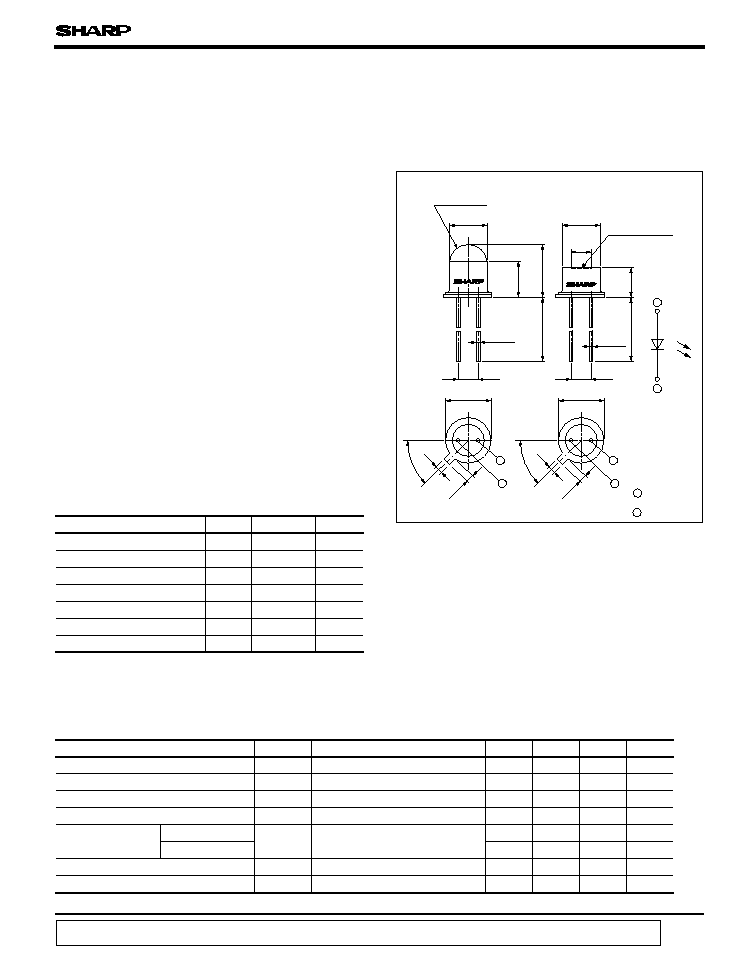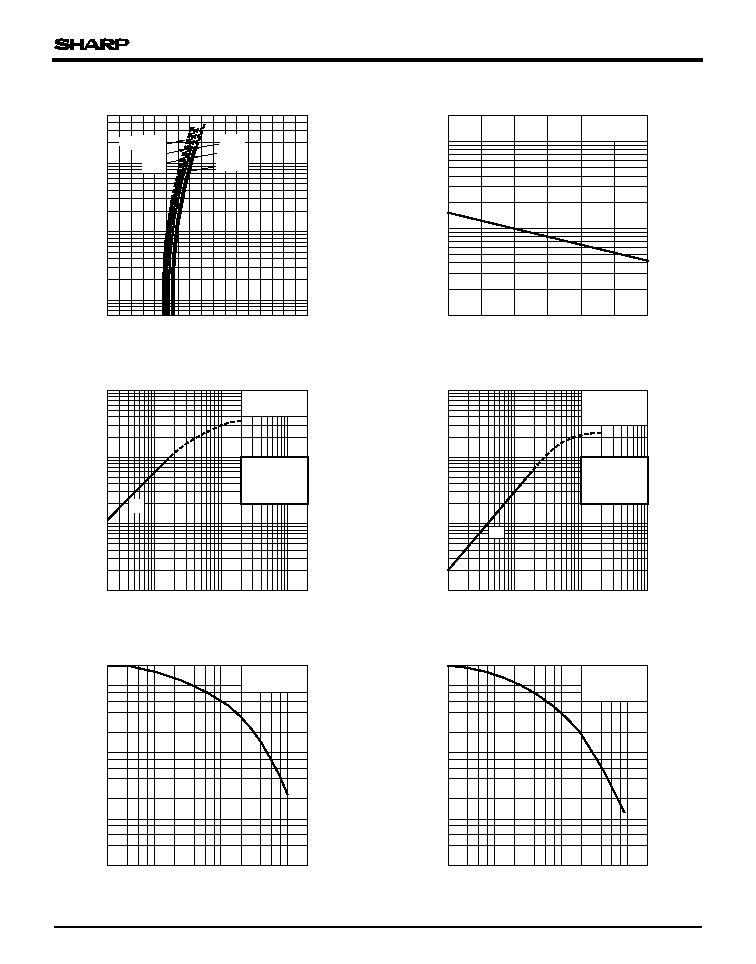
*1 Pulse width<= 200
µ
s
Duty ratio = 0.01
*2 For 10 seconds at the position of 1.3mm from the bottom
Emitting Diode
s
Features
s
Applications
GL514/GL513F
4. High reliability, long operation life
1. Optoelectronic switches
2. Smoke detectors
3. Infrared applied systems
I
F
= 100mA
I
F
= 100mA
GL514/GL513F
Parameter
Symbol
Conditions
MIN.
TYP.
MAX.
Unit
Forward voltage
V
F
I
F
= 100mA
-
1.35
1.6
V
Peak forward voltage
V
FM
I
FM
= 1.5A
-
2.75
4.0
V
Reverse current
I
R
V
R
= 5V
-
-
100
Terminal capacitance
C
t
V = 0, f = 1MHz
-
70
-
pF
GL514
e
I
F
= 100mA
3.31
5.35
10.0
mW
1.44
2.88
-
mW
GL513F
Peak emission wavelength
p
I
F
= 100mA
-
950
-
nm
Half intensity wavelength
I
F
= 100mA
-
45
-
nm
*3
Radiant flux
1.0
1.0
45
∞
2.5
GL514
Glass lens
GL514
13
4.5
2.5
1.0
45
∞
1.0
13
GL513F
GL513F
Glass window
1. Output :
GL514
e
MIN. 3.31mW at
GL513F
e
MIN. 1.44mW at
s
Outline Dimensions
(Unit : mm )
Symbol
Rating
Unit
P
250
mW
Forward current
I
F
150
mA
*1
Peak forward current
I
FM
2
A
Reverse voltage
V
R
6
V
Operating temperature
T
opr
- 40 to + 125
∞C
Storage temperature
T
stg
- 55 to + 125
∞C
*2
Soldering temperature
T
sol
260
∞C
s
Absolute Maximum Ratings
(Ta = 25∞C )
s
Electro-optical Characteristics
(Ta = 25∞C )
GL513F
:
TYP. ± 50∞
2. Beam angle :
GL514
:
TYP. ± 7∞
1
Cathode
2
Anode
1
2
1
2
1
2
µ
A
Parameter
Power dissipation
3. To- 18 type standard package
face of can package.
data books, etc. Contact SHARP in order to obtain the latest version of the device specification sheets before using any SHARP's device.
"
"
In the absence of confirmation by device specification sheets, SHARP takes no responsibility for any defects that occur in equipment using any of SHARP's devices, shown in catalogs,
TO-18 Type Infrared
3
0.45
0.45
4.7
±
0.1
4.7
±
0.1
3.7
MAX.
6.6
MAX.
5.7
MAX.
5.7
MAX.

GL514/GL513F
200
175
150
125
100
75
50
25
0
Relative radiant intensity
(
%
)
900
925
975
Wavelength
( nm )
900
920
940
880
0
20
40
80
100
10
20
50
100
200
500
Duty ratio
2
5
60
950
0
125
25
50
75
- 25
0
100
25
50
75
- 25
960
980
100
2
5
2
5
Pulse width <=200
µ
s
Forward current I
F
(
mA
)
Fig. 1 Forward Current vs.
Ambient Temperature
10
- 2
10
- 1
Fig. 3 Spectral Distribution
Peak emission wavelength
P
(
nm
)
Fig. 4 Peak Emission Wavelength vs.
Ambient Temperature
Fig. 2 Peak Forward Current vs. Duty Ratio
*
3 Classification Table of Radiant Flux
Model No.
Rank Mark
GL514A
A
5.35 to 10.0
GL514
-
3.31 to 10.0
at I
F
= 100mA, Ta = 25∞C
I
F
= 40mA
T
a
= 25∞C
- 50
125
150
Peak forward current I
FM
(
mA
)
- 50
Ambient temperature T
a
( ∞C )
T
a
= 25∞C
1
I
F
= const.
Ambient temperature T
a
( ∞C )
e
( mW )
2000
1000
1000
1000
1020
1040
- 40
- 40

GL514/GL513F
0
500
200
100
50
20
10
5
2
1
Relative radiant intensity
(
%
)
0.1
100
10
1
0.1
Distance to detector d ( mm )
0.1
0.2
0.5
2
5
10
20
50
100
0.1
0.2
0.5
1
2
5
10
20
- 25
75
50
25
100
0
1
DC
25∞C
0∞C
75∞C
50∞C
125
Relative radiant intensity
(
%
)
DC
1
100
50
20
10
5
2
0.5
0.2
0.1
1
50
20
5
2
0.5
0.2
0.2
0.5
1
2
5
10
20
50 100
100
50
20
10
5
2
1
0.5
0.2
Distance to detector d ( mm )
0.1
100
50
20
10
5
2
1
0.5
0.2
0.1
Fig. 5 Forward Current vs. Forward Voltage
Fig. 6 Relative Radiant Flux vs.
Ambient Temperature
Forward current I
F
(
mA
)
Relative radiant flux
- 25∞C
Fig. 7 Radiant Flux vs.
Fig. 8 Radiant Flux vs.
Fig. 9 Relative Radiant Intensity vs.
Fig.10 Relative Radiant Intensity vs.
Forward Current
(GL514 )
Forward Current
(GL513F)
Distance
(GL514 )
Distance
(GL513F)
1
2
3
Pulse
( Pulse width
<=200
µ
s)
Pulse
( Pulse width
<= 200
µ
s)
Radiant flux
e
(
mW
)
Forward current I
F
( mA )
Radiant flux
e
(
mW
)
Forward current I
F
( mA )
T
a
= 100∞C
Ambient temperature T
a
( ∞C )
T
a
= 25∞C
T
a
= 25∞C
T
a
= 25∞C
T
a
= 25∞C
I
F
= const.
2
5
2
5
10
2
2
5
10
3
10
4
10
2
5
2
5
10
2
2
5
10
3
10
4
Forward voltage V
F
( V)

115
Application Circuits
NOTICE
qThe circuit application examples in this publication are provided to explain representative applications of
SHARP devices and are not intended to guarantee any circuit design or license any intellectual property
rights. SHARP takes no responsibility for any problems related to any intellectual property right of a
third party resulting from the use of SHARP's devices.
qContact SHARP in order to obtain the latest device specification sheets before using any SHARP device.
SHARP reserves the right to make changes in the specifications, characteristics, data, materials,
structure, and other contents described herein at any time without notice in order to improve design or
reliability. Manufacturing locations are also subject to change without notice.
qObserve the following points when using any devices in this publication. SHARP takes no responsibility
for damage caused by improper use of the devices which does not meet the conditions and absolute
maximum ratings to be used specified in the relevant specification sheet nor meet the following
conditions:
(i) The devices in this publication are designed for use in general electronic equipment designs such as:
--- Personal computers
--- Office automation equipment
--- Telecommunication equipment [terminal]
--- Test and measurement equipment
--- Industrial control
--- Audio visual equipment
--- Consumer electronics
(ii)Measures such as fail-safe function and redundant design should be taken to ensure reliability and
safety when SHARP devices are used for or in connection with equipment that requires higher
reliability such as:
--- Transportation control and safety equipment (i.e., aircraft, trains, automobiles, etc.)
--- Traffic signals
--- Gas leakage sensor breakers
--- Alarm equipment
--- Various safety devices, etc.
(iii)SHARP devices shall not be used for or in connection with equipment that requires an extremely
high level of reliability and safety such as:
--- Space applications
--- Telecommunication equipment [trunk lines]
--- Nuclear power control equipment
--- Medical and other life support equipment (e.g., scuba).
qContact a SHARP representative in advance when intending to use SHARP devices for any "specific"
applications other than those recommended by SHARP or when it is unclear which category mentioned
above controls the intended use.
qIf the SHARP devices listed in this publication fall within the scope of strategic products described in the
Foreign Exchange and Foreign Trade Control Law of Japan, it is necessary to obtain approval to export
such SHARP devices.
qThis publication is the proprietary product of SHARP and is copyrighted, with all rights reserved. Under
the copyright laws, no part of this publication may be reproduced or transmitted in any form or by any
means, electronic or mechanical, for any purpose, in whole or in part, without the express written
permission of SHARP. Express written permission is also required before any use of this publication
may be made by a third party.
qContact and consult with a SHARP representative if there are any questions about the contents of this
publication.




